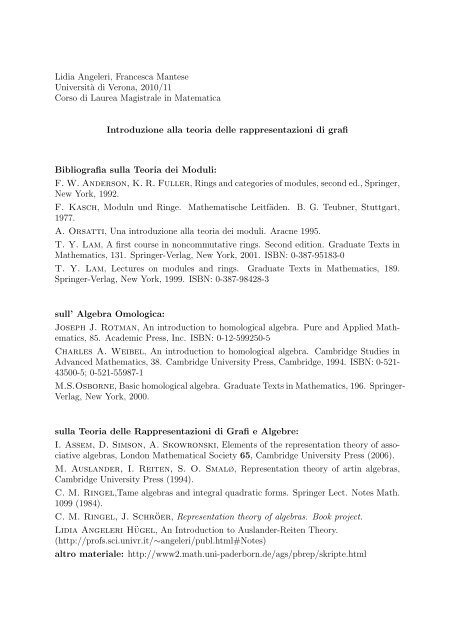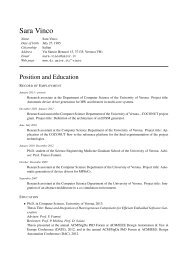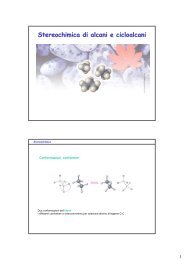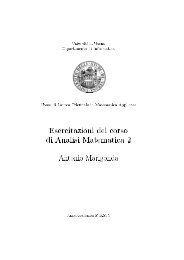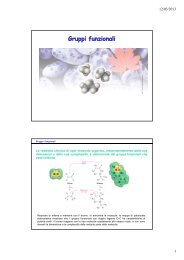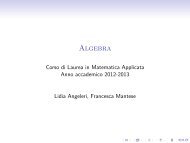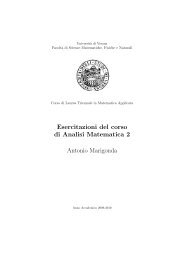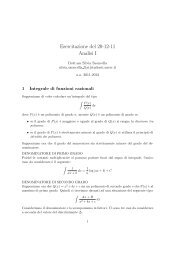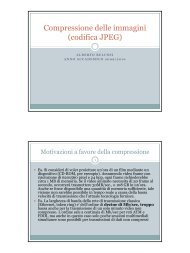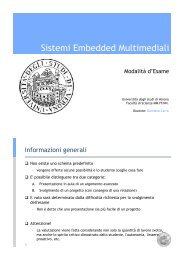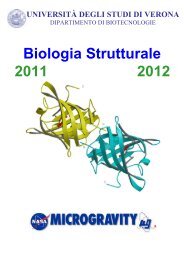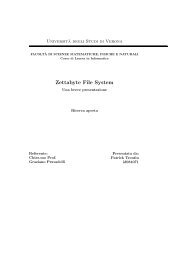Lidia Angeleri, Francesca Mantese Universit`a di Verona, 2010/11 ...
Lidia Angeleri, Francesca Mantese Universit`a di Verona, 2010/11 ...
Lidia Angeleri, Francesca Mantese Universit`a di Verona, 2010/11 ...
Create successful ePaper yourself
Turn your PDF publications into a flip-book with our unique Google optimized e-Paper software.
<strong>Li<strong>di</strong>a</strong> <strong>Angeleri</strong>, <strong>Francesca</strong> <strong>Mantese</strong><br />
Università <strong>di</strong> <strong>Verona</strong>, <strong>2010</strong>/<strong>11</strong><br />
Corso <strong>di</strong> Laurea Magistrale in Matematica<br />
Introduzione alla teoria delle rappresentazioni <strong>di</strong> grafi<br />
Bibliografia sulla Teoria dei Moduli:<br />
F. W. Anderson, K. R. Fuller, Rings and categories of modules, second ed., Springer,<br />
New York, 1992.<br />
F. Kasch, Moduln und Ringe. Mathematische Leitfäden. B. G. Teubner, Stuttgart,<br />
1977.<br />
A. Orsatti, Una introduzione alla teoria dei moduli. Aracne 1995.<br />
T. Y. Lam, A first course in noncommutative rings. Second e<strong>di</strong>tion. Graduate Texts in<br />
Mathematics, 131. Springer-Verlag, New York, 2001. ISBN: 0-387-95183-0<br />
T. Y. Lam, Lectures on modules and rings. Graduate Texts in Mathematics, 189.<br />
Springer-Verlag, New York, 1999. ISBN: 0-387-98428-3<br />
sull’ Algebra Omologica:<br />
Joseph J. Rotman, An introduction to homological algebra. Pure and Applied Mathematics,<br />
85. Academic Press, Inc. ISBN: 0-12-599250-5<br />
Charles A. Weibel, An introduction to homological algebra. Cambridge Stu<strong>di</strong>es in<br />
Advanced Mathematics, 38. Cambridge University Press, Cambridge, 1994. ISBN: 0-521-<br />
43500-5; 0-521-55987-1<br />
M.S.Osborne, Basic homological algebra. Graduate Texts in Mathematics, 196. Springer-<br />
Verlag, New York, 2000.<br />
sulla Teoria delle Rappresentazioni <strong>di</strong> Grafi e Algebre:<br />
I. Assem, D. Simson, A. Skowronski, Elements of the representation theory of associative<br />
algebras, London Mathematical Society 65, Cambridge University Press (2006).<br />
M. Auslander, I. Reiten, S. O. Smalø, Representation theory of artin algebras,<br />
Cambridge University Press (1994).<br />
C. M. Ringel,Tame algebras and integral quadratic forms. Springer Lect. Notes Math.<br />
1099 (1984).<br />
C. M. Ringel, J. Schröer, Representation theory of algebras. Book project.<br />
<strong>Li<strong>di</strong>a</strong> <strong>Angeleri</strong> Hügel, An Introduction to Auslander-Reiten Theory.<br />
(http://profs.sci.univr.it/∼angeleri/publ.html#Notes)<br />
altro materiale: http://www2.math.uni-paderborn.de/ags/pbrep/skripte.html
<strong>Li<strong>di</strong>a</strong> <strong>Angeleri</strong>, <strong>Francesca</strong> <strong>Mantese</strong><br />
Università <strong>di</strong> <strong>Verona</strong>, <strong>2010</strong>/<strong>11</strong><br />
Corso <strong>di</strong> Laurea Magistrale in Matematica<br />
Introduzione alla teoria delle rappresentazioni <strong>di</strong> grafi<br />
Programma svolto nel Secondo Modulo<br />
Cenni <strong>di</strong> algebra omologica<br />
1 Push out e pull back<br />
1. Push out e pull back<br />
2. Proposizione (successioni esatte corte indotte βɛ e ɛα)<br />
3. Osservazioni<br />
4. Lemma del serpente<br />
5. Naturalità nel Lemma del serpente<br />
2 Il funtore Ext 1<br />
1. Il gruppo delle estensioni Ext 1 R(A, B)<br />
2. Le applicazioni Ext 1 R(A, β) e Ext 1 R(α, B)<br />
3. Proposizione su Ext 1 R(α, β)<br />
4. la somma <strong>di</strong> Baer<br />
5. Teorema: la struttura <strong>di</strong> gruppo su Ext 1 R(A, B)<br />
3 Risoluzioni proiettive<br />
1. Richiamo: complesso, mappa <strong>di</strong> catene, gruppi <strong>di</strong> omologia<br />
2. Mappe <strong>di</strong> catene omotopiche<br />
3. Lemma: mappe <strong>di</strong> catene omotopiche coincidono sui gruppi <strong>di</strong> omologia<br />
4. Risoluzioni proiettive<br />
5. Teorema: sollevamento <strong>di</strong> omomorfismi a una risoluzione proiettiva<br />
4 I funtori Ext n<br />
1. Teorema: Hom e Ext 1 come gruppi <strong>di</strong> omologia del complesso HomR(P • , B)<br />
2. Esempi<br />
3. Definizione dei funtori Ext n<br />
4. Richiamo: la successione esatta lunga dei gruppi <strong>di</strong> omologia<br />
5. Teorema: la successione esatta lunga dei gruppi <strong>di</strong> estensione<br />
6. Osservazione<br />
7. Corollario: Ext 1 R(A, B) come conucleo
Teoria <strong>di</strong> Auslander-Reiten<br />
5 Il trasposto <strong>di</strong> Auslander-Bridger<br />
1. Richiamo sui proiettivi<br />
2. Osservazione: esistenza <strong>di</strong> una risoluzione proiettiva minimale<br />
3. Definizione del trasposto Tr A<br />
4. Lemma: prime proprietà del trasposto Tr A<br />
5. Osservazione su Tr f<br />
6. P (M, N) e Hom R(M, N)<br />
7. Proposizione: Hom R(M, N) ∼ = Hom R(Tr N, Tr M)<br />
8. La categoria stabile modulo proiettivi<br />
9. Dualità <strong>di</strong> Auslander-Bridger<br />
6 Il prodotto tensoriale<br />
1. Richiamo: il prodotto tensoriale<br />
2. Aggiunzione <strong>di</strong> Hom e ⊗<br />
3. Il funtore A ⊗ −<br />
4. Lemma: Hom(P, M) ∼ = P ∗ ⊗ M<br />
5. Proposizione: la successione esatta lunga data dal trasposto<br />
7 La formula <strong>di</strong> Auslander-Reiten<br />
1. Il funtore <strong>di</strong> Nakayama e τ<br />
2. Esempio<br />
3. La categoria stabile modulo iniettivi<br />
4. La traslazione <strong>di</strong> Auslander-Reiten<br />
5. La formula <strong>di</strong> Auslander-Reiten<br />
6. Lemma<br />
7. Esempio<br />
3
8 Sequenze <strong>di</strong> Auslander-Reiten<br />
1. Lemma<br />
2. Applicazioni quasi spezzanti<br />
3. Teorema <strong>di</strong> esistenza<br />
4. Applicazioni minimali a destra e a sinistra<br />
5. Sequenze <strong>di</strong> Auslander-Reiten<br />
6. Proposizione: unicità <strong>di</strong> una successione quasi spezzante<br />
7. Teorema <strong>di</strong> Auslander-Reiten<br />
9 Il quiver <strong>di</strong> Auslander-Reiten<br />
1. Applicazioni quasi-spezzanti per proiettivi e iniettivi<br />
2. Morfismi irriducibili<br />
3. Morfismi irriducibili come componenti delle applicazioni quasi spezzanti<br />
4. r n (M, N)<br />
5. I morfismi irriducibili sono gli elementi <strong>di</strong> r(M, N) \ r 2 (M, N)<br />
6. Numero delle componenti delle applicazioni quasi spezzanti<br />
7. Il quiver Γ <strong>di</strong> Auslander-Reiten<br />
8. Esempio<br />
9. Costruzione <strong>di</strong> Γ per traslazione e maglie<br />
10. Esempio rivisitato<br />
<strong>11</strong>. Knitting Procedure per le componenti preproiettive e preiniettive<br />
10 Algebre <strong>di</strong> tipo finito e <strong>di</strong> tipo mansueto<br />
1. Algebre <strong>di</strong> tipo <strong>di</strong> rappresentazione finito<br />
2. Teorema <strong>di</strong> classificazione <strong>di</strong> Gabriel (grafi <strong>di</strong> Dynkin e grafi Euclidei)<br />
3. Il vettore delle <strong>di</strong>mensioni<br />
4. Teorema <strong>di</strong> Gabriel-Riedtmann sulle componenti preproiettive e preiniettive<br />
5. Esempio<br />
6. Teoremi <strong>di</strong> Auslander sul quiver <strong>di</strong> Auslander-Reiten per un’algebra <strong>di</strong> tipo finito<br />
7. Componenti regolari<br />
8. La matrice <strong>di</strong> Cartan e la trasformazione <strong>di</strong> Coxeter<br />
9. L’algebra <strong>di</strong> Kronecker<br />
4
Introduzione alla teoria delle rappresentazioni <strong>di</strong> grafi 1<br />
TAME AND WILD ALGEBRAS<br />
Definition. For each module A ∈ Λ mod denote by <strong>di</strong>mA = (m1, . . . , mn) ∈ Z n the<br />
<strong>di</strong>mension vector of A given by the Jordan-Hölder multiplicities, that is, mi is the number<br />
of composition factors of A that are isomorphic to the simple module Si for aech 1 ≤ i ≤ n.<br />
We set<br />
ei = (0, . . . , 1, 0, . . . , 0) = <strong>di</strong>mSi<br />
pi = <strong>di</strong>m Λei = <strong>di</strong>mPi<br />
qi = <strong>di</strong>m D(eiΛ) = <strong>di</strong>mIi<br />
Remark. (1) For every exact sequence 0 → A ′ → A → A ′′ → 0 we have<br />
(2) If <strong>di</strong>mA = (m1, . . . , mn), then l(A) =<br />
<strong>di</strong>mA = <strong>di</strong>mA ′ + <strong>di</strong>mA ′′<br />
n<br />
mi.<br />
i=1<br />
(3) Consider the Grothen<strong>di</strong>eck group K0(Λ) defined as the group generated by the isomorphism<br />
classes [A] of Λ mod with the relations [A ′ ] + [A ′′ ] = [A] whenever 0 → A ′ →<br />
A → A ′′ → 0 is exact in Λ mod. Note that K0(Λ) is a free abelian group with basis<br />
[S1], . . . , [Sn], see [1, I,1.7]. The assignment [A] ↦→ <strong>di</strong>mA defines an isomorphism between<br />
K0(Λ) and Z n .<br />
Theorem [Gabriel 1972] Let Λ be a finite <strong>di</strong>mensional here<strong>di</strong>tary algebra over an<br />
algebraically closed field k, and let Q be the Gabriel-quiver of Λ. The following statements<br />
are equivalent.<br />
(a) Λ is of finite representations type.<br />
(b) Q is of Dynkin type, that is, its underlying graph belongs to the following list.<br />
An :• • • . . . • •<br />
•<br />
Dn : ❅•<br />
•<br />
• . . . •<br />
•<br />
•<br />
E6 :• • • • •<br />
•<br />
E7 :• • • • • •<br />
•<br />
E8 :• • • • • • •<br />
Moreover, if (a) - (b) are satisfied, the finite <strong>di</strong>mensional indecomposable modules are<br />
uniquely determined by their <strong>di</strong>mension vector.
2 <strong>Li<strong>di</strong>a</strong> <strong>Angeleri</strong><br />
Remark. Let Λ be a finite <strong>di</strong>mensional here<strong>di</strong>tary algebra over an algebraically closed<br />
field k, and let Q be the Gabriel-quiver of Λ. If Q is of Euclidean type, that is, its<br />
underlying graph belongs to the following list:<br />
An : <br />
• . . . •<br />
• ❅•<br />
❅•<br />
• •<br />
•<br />
Dn : ❅•<br />
•<br />
• . . . •<br />
•<br />
•<br />
•<br />
•<br />
❅•<br />
E6 :• • • • •<br />
E7 :• • •<br />
•<br />
• • • •<br />
E8 :• •<br />
•<br />
• • • • • •<br />
then Λ is said to be tame of infinite representation type. Also in this case the isomorphism<br />
classes of indecomposable finite <strong>di</strong>mensional modules, though infinite in number, can be<br />
classified.<br />
There is a general definiton of tameness for arbitrary finite <strong>di</strong>mensional algebras. A<br />
finite-<strong>di</strong>mensional k-algebra Λ over an algebraically closed field k is called tame if, for<br />
each <strong>di</strong>mension d, there are finitely many Λ-k[x]-bimodules M1, · · · , Mn which are free<br />
of rank d as right k[x]-modules, such that every indecomposable Λ-module of <strong>di</strong>mension<br />
d is isomorphic to Mi ⊗k[x] k[x]/(x − λ) for some 1 ≤ i ≤ n and λ ∈ k. In other<br />
words, Λ is tame iff for each <strong>di</strong>mension d there is a finite number of one-parameter<br />
families of indecomposable d-<strong>di</strong>mensional modules such that all indecomposable modules<br />
of <strong>di</strong>mension d belong (up to isomorphism) to one of these families.<br />
Moreover, Λ is said to be of wild representation type if there is a representation embed<strong>di</strong>ng<br />
from k < x, y >mod into Λ mod, where k < x, y > denotes the free associative algebra in<br />
two non-commuting variables, see [2]. Observe that in this case there is a representation<br />
embed<strong>di</strong>ng AMod → Λ Mod for any finite <strong>di</strong>mensional k-algebra A, and furthermore, any<br />
finite <strong>di</strong>mensional k-algebra A occurs as the endomorphism ring of some Λ-module.<br />
A celebrated theorem of Drozd [3] states that every finite <strong>di</strong>mensional algebra Λ over an<br />
algebraically closed field k is either tame or wild.<br />
References<br />
[1] M. Auslander, I. Reiten, S. O. Smalø, Representation theory of artin algebras, Cambridge Univ. Press<br />
(1994).<br />
[2] W. Crawley-Boevey, Modules of finite length over their endomorphism ring, in Representations of algebras<br />
and related topics, eds. S. Brenner and H. Tachikawa, London Math. Soc. Lec. Notes Series 168 (1992), 127-<br />
184.<br />
[3] Yu. Drozd, Tame and wild matrix problems, in Representations and quadratic forms (Institute of Mathematics,<br />
Academy of Sciences, Ukranian SSR, Kiev 1979), 39-74. Amer. Math. Soc. Transl. 128 (1986),<br />
31-55.
ALGEBRAS OF FINITE REPRESENTATION TYPE<br />
Definition. An Artin algebra Λ is said to be of finite representation type if there are only<br />
finitely many isomorphism classes of finitely generated indecomposable left Λ-modules.<br />
(equivalently: there are only finitely many isomorphism classes of finitely generated indecomposable<br />
right Λ-modules; indeed, the transpose Tr yields a bijection between the<br />
isomorphism classes of indecomposable non-projective left and right Λ-modules.)<br />
Artin algebras of finite representation type are completely described by their AR-quiver.<br />
Theorem 1 [Auslander, Ringel-Tachikawa 1974] Let Λ be a finite <strong>di</strong>mensional algebra<br />
of finite representation type. Then every module is a <strong>di</strong>rect sum of finitely generated<br />
indecomposable modules. Moreover, every non-zero non-isomorphism f : X → Y between<br />
indecomposable modules X, Y is a sum of compositions of irreducible maps between indecomposable<br />
modules.<br />
Remark In [2], Auslander also proved the converse of the first statement in Theorem 1.<br />
In other words, a finite <strong>di</strong>mensional algebra is of finite representation type if and only if<br />
every left module is a <strong>di</strong>rect sum of indecomposable left modules. The question whether<br />
the same holds true for any left artinian ring is known as the Pure-Semisimple Conjecture.<br />
Theorem 2 [Auslander 1974] Let Λ be an indecomposable finite <strong>di</strong>mensional algebra<br />
with AR-quiver Γ. Assume that Γ has a connected component C such that the lengths of<br />
the modules in C are bounded. Then Λ is of finite representation type, and Γ = C.<br />
In particular, of course, this applies to the case where Γ has a finite component.<br />
Theorem 2 confirms the<br />
First Brauer-Thrall-Conjecture: An Artin algebra is of finite representation type if<br />
and only if the lengths of the indecomposable finitely generated modules are bounded.<br />
The following conjecture is verified for finite <strong>di</strong>mensional algebras over perfect fields, but<br />
it is still open in general.<br />
Second Brauer-Thrall-Conjecture: If Λ is a finite <strong>di</strong>mensional k-algebra where k<br />
is an infinite field, and Λ is not of finite representation type, then there are infinitely<br />
many n1, n2, n3, · · · ∈ N and for each nk there are infinitely many isomorphism classes of<br />
indecomposable Λ-modules of length nk.<br />
References<br />
[1] M. Auslander, Representation theory of artin algebras II, Comm. Algebra 1 (1974), 269-310.<br />
[2] M. Auslander, Large modules over artin algebras, in Algebra, Topology, Categories; Acad.Press 1976, 1-17.<br />
[3] R. Bautista, On algebras of strongly unbounded representation type, Comm.Math.Helv.60 (1985), 392-399.<br />
[4] C. M. Ringel, H. Tachikawa, QF-3 rings, J. Reine Angew. Math. 272 (1975), 49-72.<br />
[5] A. V. Roiter, Unboundedness of the <strong>di</strong>mension of the indecomposable representations of an algebra which<br />
has infinitely many indecomposable representations. Izv. Akad. Nauk SSSR Ser. Mat.32 (1968), 1275-1282.<br />
[6] S. O. Smalø, The inductive step of the second Brauer-Thrall conjecture, Can. J. Math. 32 (1980) 342-349.<br />
3


